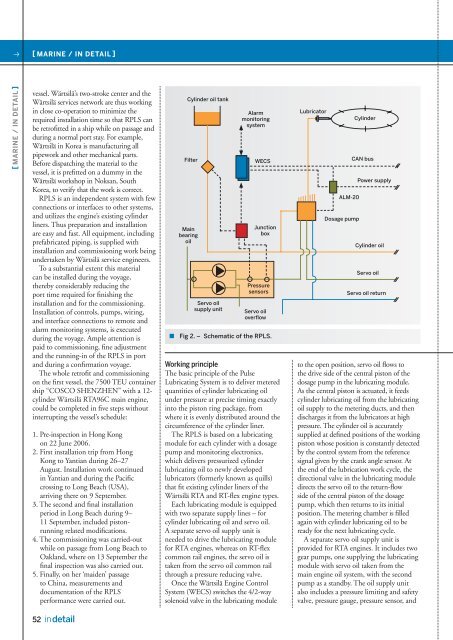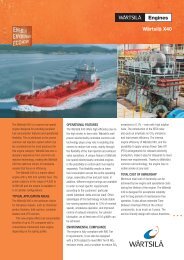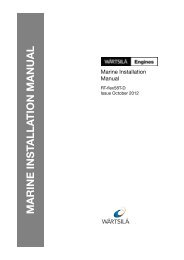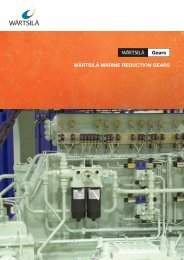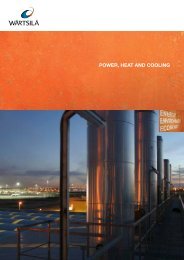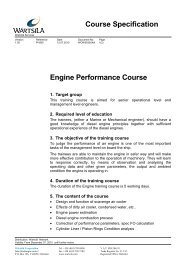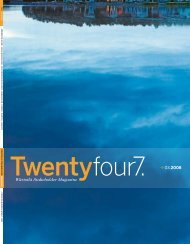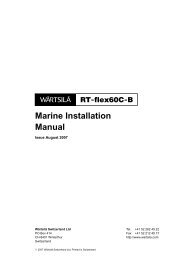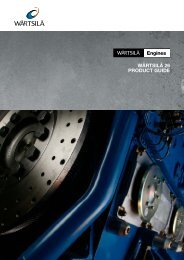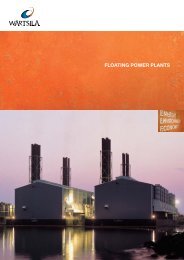Cutting cylinder oil costs without a break in service - Wärtsilä
Cutting cylinder oil costs without a break in service - Wärtsilä
Cutting cylinder oil costs without a break in service - Wärtsilä
You also want an ePaper? Increase the reach of your titles
YUMPU automatically turns print PDFs into web optimized ePapers that Google loves.
p [ MARINE / IN DETAIL ]<br />
[ MARINE / IN DETAIL ]<br />
vessel. <strong>Wärtsilä</strong>’s two-stroke center and the<br />
<strong>Wärtsilä</strong> <strong>service</strong>s network are thus work<strong>in</strong>g<br />
<strong>in</strong> close co-operation to m<strong>in</strong>imize the<br />
required <strong>in</strong>stallation time so that RPLS can<br />
be retrofitted <strong>in</strong> a ship while on passage and<br />
dur<strong>in</strong>g a normal port stay. For example,<br />
<strong>Wärtsilä</strong> <strong>in</strong> Korea is manufactur<strong>in</strong>g all<br />
pipework and other mechanical parts.<br />
Before dispatch<strong>in</strong>g the material to the<br />
vessel, it is prefitted on a dummy <strong>in</strong> the<br />
<strong>Wärtsilä</strong> workshop <strong>in</strong> Noksan, South<br />
Korea, to verify that the work is correct.<br />
RPLS is an <strong>in</strong>dependent system with few<br />
connections or <strong>in</strong>terfaces to other systems,<br />
and utilizes the eng<strong>in</strong>e’s exist<strong>in</strong>g <strong>cyl<strong>in</strong>der</strong><br />
l<strong>in</strong>ers. Thus preparation and <strong>in</strong>stallation<br />
are easy and fast. All equipment, <strong>in</strong>clud<strong>in</strong>g<br />
prefabricated pip<strong>in</strong>g, is supplied with<br />
<strong>in</strong>stallation and commission<strong>in</strong>g work be<strong>in</strong>g<br />
undertaken by <strong>Wärtsilä</strong> <strong>service</strong> eng<strong>in</strong>eers.<br />
To a substantial extent this material<br />
can be <strong>in</strong>stalled dur<strong>in</strong>g the voyage,<br />
thereby considerably reduc<strong>in</strong>g the<br />
port time required for fi nish<strong>in</strong>g the<br />
<strong>in</strong>stallation and for the commission<strong>in</strong>g.<br />
Installation of controls, pumps, wir<strong>in</strong>g,<br />
and <strong>in</strong>terface connections to remote and<br />
alarm monitor<strong>in</strong>g systems, is executed<br />
dur<strong>in</strong>g the voyage. Ample attention is<br />
paid to commission<strong>in</strong>g, fi ne adjustment<br />
and the runn<strong>in</strong>g-<strong>in</strong> of the RPLS <strong>in</strong> port<br />
and dur<strong>in</strong>g a confi rmation voyage.<br />
The whole retrofit and commission<strong>in</strong>g<br />
on the first vessel, the 7500 TEU conta<strong>in</strong>er<br />
ship “COSCO SHENZHEN” with a 12<strong>cyl<strong>in</strong>der</strong><br />
<strong>Wärtsilä</strong> RTA96C ma<strong>in</strong> eng<strong>in</strong>e,<br />
could be completed <strong>in</strong> five steps <strong>without</strong><br />
<strong>in</strong>terrupt<strong>in</strong>g the vessel’s schedule:<br />
1. Pre-<strong>in</strong>spection <strong>in</strong> Hong Kong<br />
on 22 June 2006.<br />
2. First <strong>in</strong>stallation trip from Hong<br />
Kong to Yantian dur<strong>in</strong>g 26–27<br />
August. Installation work cont<strong>in</strong>ued<br />
<strong>in</strong> Yantian and dur<strong>in</strong>g the Pacifi c<br />
cross<strong>in</strong>g to Long Beach (USA),<br />
arriv<strong>in</strong>g there on 9 September.<br />
3. The second and fi nal <strong>in</strong>stallation<br />
period <strong>in</strong> Long Beach dur<strong>in</strong>g 9–<br />
11 September, <strong>in</strong>cluded pistonrunn<strong>in</strong>g<br />
related modifi cations.<br />
4. The commission<strong>in</strong>g was carried-out<br />
while on passage from Long Beach to<br />
Oakland, where on 13 September the<br />
f<strong>in</strong>al <strong>in</strong>spection was also carried out.<br />
5. F<strong>in</strong>ally, on her ‘maiden’ passage<br />
to Ch<strong>in</strong>a, measurements and<br />
documentation of the RPLS<br />
performance were carried out.<br />
52 <strong>in</strong>detail<br />
Cyl<strong>in</strong>der <strong>oil</strong> tank<br />
Alarm<br />
monitor<strong>in</strong>g<br />
system<br />
Filter WECS<br />
Ma<strong>in</strong><br />
bear<strong>in</strong>g<br />
<strong>oil</strong><br />
Servo <strong>oil</strong><br />
supply unit<br />
Junction<br />
box<br />
Pressure<br />
sensors<br />
Servo <strong>oil</strong><br />
overfl ow<br />
Fig 2. – Schematic of the RPLS.<br />
Work<strong>in</strong>g pr<strong>in</strong>ciple<br />
The basic pr<strong>in</strong>ciple of the Pulse<br />
Lubricat<strong>in</strong>g System is to deliver metered<br />
quantities of <strong>cyl<strong>in</strong>der</strong> lubricat<strong>in</strong>g <strong>oil</strong><br />
under pressure at precise tim<strong>in</strong>g exactly<br />
<strong>in</strong>to the piston r<strong>in</strong>g package, from<br />
where it is evenly distributed around the<br />
circumference of the <strong>cyl<strong>in</strong>der</strong> l<strong>in</strong>er.<br />
The RPLS is based on a lubricat<strong>in</strong>g<br />
module for each <strong>cyl<strong>in</strong>der</strong> with a dosage<br />
pump and monitor<strong>in</strong>g electronics,<br />
which delivers pressurized <strong>cyl<strong>in</strong>der</strong><br />
lubricat<strong>in</strong>g <strong>oil</strong> to newly developed<br />
lubricators (formerly known as quills)<br />
that fit exist<strong>in</strong>g <strong>cyl<strong>in</strong>der</strong> l<strong>in</strong>ers of the<br />
<strong>Wärtsilä</strong> RTA and RT-flex eng<strong>in</strong>e types.<br />
Each lubricat<strong>in</strong>g module is equipped<br />
with two separate supply l<strong>in</strong>es – for<br />
<strong>cyl<strong>in</strong>der</strong> lubricat<strong>in</strong>g <strong>oil</strong> and servo <strong>oil</strong>.<br />
A separate servo <strong>oil</strong> supply unit is<br />
needed to drive the lubricat<strong>in</strong>g module<br />
for RTA eng<strong>in</strong>es, whereas on RT-fl ex<br />
common rail eng<strong>in</strong>es, the servo <strong>oil</strong> is<br />
taken from the servo <strong>oil</strong> common rail<br />
through a pressure reduc<strong>in</strong>g valve.<br />
Once the <strong>Wärtsilä</strong> Eng<strong>in</strong>e Control<br />
System (WECS) switches the 4/2-way<br />
solenoid valve <strong>in</strong> the lubricat<strong>in</strong>g module<br />
Lubricator<br />
ALM-20<br />
Dosage pump<br />
Cyl<strong>in</strong>der<br />
CAN bus<br />
Power supply<br />
Cyl<strong>in</strong>der <strong>oil</strong><br />
Servo <strong>oil</strong><br />
Servo <strong>oil</strong> return<br />
to the open position, servo <strong>oil</strong> fl ows to<br />
the drive side of the central piston of the<br />
dosage pump <strong>in</strong> the lubricat<strong>in</strong>g module.<br />
As the central piston is actuated, it feeds<br />
<strong>cyl<strong>in</strong>der</strong> lubricat<strong>in</strong>g <strong>oil</strong> from the lubricat<strong>in</strong>g<br />
<strong>oil</strong> supply to the meter<strong>in</strong>g ducts, and then<br />
discharges it from the lubricators at high<br />
pressure. The <strong>cyl<strong>in</strong>der</strong> <strong>oil</strong> is accurately<br />
supplied at def<strong>in</strong>ed positions of the work<strong>in</strong>g<br />
piston whose position is constantly detected<br />
by the control system from the reference<br />
signal given by the crank angle sensor. At<br />
the end of the lubrication work cycle, the<br />
directional valve <strong>in</strong> the lubricat<strong>in</strong>g module<br />
directs the servo <strong>oil</strong> to the return-fl ow<br />
side of the central piston of the dosage<br />
pump, which then returns to its <strong>in</strong>itial<br />
position. The meter<strong>in</strong>g chamber is fi lled<br />
aga<strong>in</strong> with <strong>cyl<strong>in</strong>der</strong> lubricat<strong>in</strong>g <strong>oil</strong> to be<br />
ready for the next lubricat<strong>in</strong>g cycle.<br />
A separate servo <strong>oil</strong> supply unit is<br />
provided for RTA eng<strong>in</strong>es. It <strong>in</strong>cludes two<br />
gear pumps, one supply<strong>in</strong>g the lubricat<strong>in</strong>g<br />
module with servo <strong>oil</strong> taken from the<br />
ma<strong>in</strong> eng<strong>in</strong>e <strong>oil</strong> system, with the second<br />
pump as a standby. The <strong>oil</strong> supply unit<br />
also <strong>in</strong>cludes a pressure limit<strong>in</strong>g and safety<br />
valve, pressure gauge, pressure sensor, and


